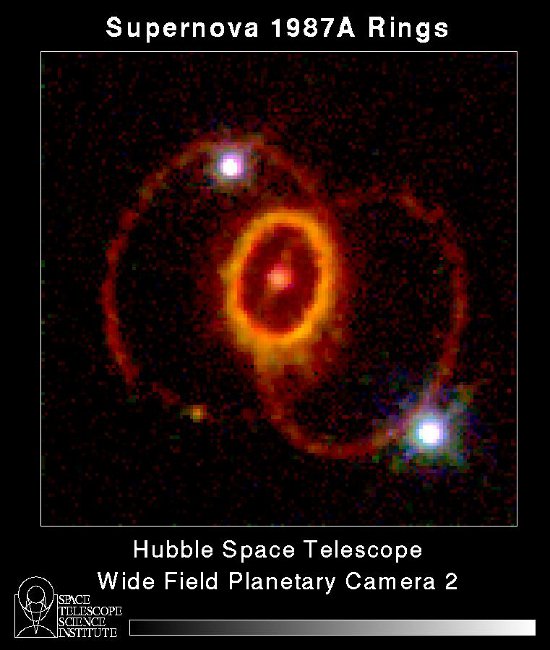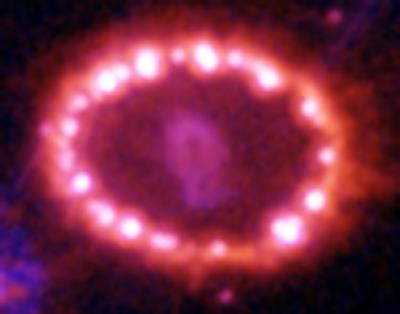In October 1604, the famous astronomer Johannes Kepler saw with his naked eye (and later observed in detail) what he thought to be a new star. In fact, what he saw was the explosion of an old star -- a supernova. Over a period of centuries, there was no further historical record of a naked-eye supernova. Some jokingly said that this was because there hasn't been a truly great astronomer since Kepler.
On February 23, 1987, however, something dramatic happened. Canadian astronomer Ian Shelton discovered a new supernova in our neighboring galaxy, the Large Magellanic Cloud, and that supernova was visible to the naked eye. According to tradition, since that was the first supernova (SN) observed in 1987, it was dubbed SN1987A (the second in any given year is denoted by the letter B, and so on). I personally remember the tremendous excitement that this supernova, a mere 167,000 light-years away (very near, by cosmic standards), caused. Soon, every telescope on the face of the Earth's southern hemisphere (where it was visible) and in space was directed to it.
The initial observations delivered an immediate surprise. Based on the theory of supernova explosions, the expectation was that the exploding star should have been a red supergiant. Instead, previous observations of the precise location of the explosion revealed that the exploding star was a blue supergiant. Eventually, astronomers understood that the star had suffered severe mass loss during its evolution, making it more compact and hotter (and therefore blue).

Figure 1. Credit: Dr. Christopher Burrows, ESA/STScI and NASA.
Remarkably, one of the key predictions of supernova theory was readily confirmed. Supernova explosions occur when the dense core of a massive star collapses to form a neutron star (a very compact object, only about 12 miles in diameter), producing copious amounts of neutrinos in the process. Detectors, located deep underground in Ohio and Japan, indeed identified about a dozen of these elusive neutrinos as they passed through the Earth. This constituted an immense theoretical and experimental success.
After its launch, the Hubble Space Telescope also viewed SN1987A, and those observations revealed a mysterious structure of three rings (Figure 1). It took astrophysicists quite a while to understand their origin. Basically, mass loss from the star prior to the explosion formed an equatorial ring of material. An hourglass shape -- in which the equatorial ring formed its "waist" -- accompanied this, and fast-moving material expanding in a perpendicular direction formed the lobes. The outer rings mark the rim of the two lobes. The ultraviolet flash from the explosion heated all the rings, which consequently began to emit radiation.

Figure 2. NASA, P. Challis, R. Kirshner (Harvard-Smithsonian Center for Astrophysics) and B. Sugerman (STScI).
In 2001, ejecta from the supernova eventually began colliding with the inner ring. The collisions still continue today, causing that ring to shine like a bracelet of pearls (Figure 2).
Supernova 1987A has given astronomers an unprecedented look at what can happen to a massive star before and after it explodes, though why we have not observed the radio pulses expected from a spinning neutron star is still a mystery. There are three potential explanations: (1) The pulsar is obscured by heavy dust. (2) The Earth is not in the line of sight of the beam of this radio "lighthouse." (3) The collapsing core has, in fact, formed a black hole rather than a neutron star. Hubble, the Chandra X-Ray Observatory, and the Herschel Space Observatory continue to monitor the evolution of this supernova remnant, and there is no doubt that it will also be a target for the upcoming James Webb Space Telescope.
Supernovae eject into space elements needed for life, such as oxygen, phosphorus, and iron. SN1987A therefore provided us with a glimpse of our own beginnings.